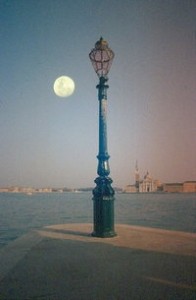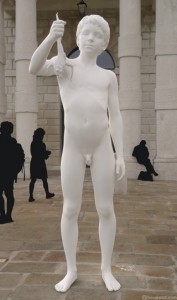The real news is not that a statue was put where the street lamp used to be — this happened a year and a half ago.
What’s worth talking about is that the resulting public protest may be having some effect.
Protests here usually involve some letters and op-ed pieces in the paper and a lot of discontented murmuring in the bars and cafes. But now Facebook has made itself felt, which has made protesting a whole new game.
It all involves the Opprobrious Case of the Lamp and the Frog. Translation: Yet another in the endless procession of municipal decisions which are made for reasons which mean nothing to the dwindling indigenous population; in this case, the removing of the old street lamp at the Customs House Point to make room for said undraped youth.

To make it worse, this administrative Coup de Lamp has occurred on public space coopted for private something: Gain, notoriety, or any other motive not involving Venetian history or its inhabitants. Or, as I think of it, another example of the insatiable desire felt by people in business to use the city as a stage set for personal gain. It is an impressive bit of scenery against which to place your product, this is undeniable.
Here is what has happened and how the story may — MAY — turn out to have a happy ending.
The Customs House building (1677), sitting at the eponymous point, the tip of Dorsoduro facing the Bacino of San Marco, was dilapidated and unused for years.
Then in 2007 or 2008, an intergalactically rich French businessman named Francois Pinault worked out a deal with the city: He would pay for the restoration of the historic building in exchange for the right to transform it into a modern art museum displaying his own intergalactically famous modern art collection. Named Punta della Dogana (Customs House Point), the museum opened on June 6, 2009.

I’ve noticed that modesty does not usually, or ever, aid you in amassing unfathomable wealth, and I present Mr. Pinault as a case in point. He owns a holding company named Artemis which comprises Converse shoes, Samsonite luggage, the Vail Ski Resort, Chateau Latour, and Christie’s auction house. You don’t make a fortune of $19 billion by playing “Mother, may I?” You just forge ahead.
Bear with me for another paragraph or two, because context is important.
For some 20 years, Fiat, the car company, was the proud owner of the museum housed in the Palazzo Grassi. It was the go-to place for important mega-shows, like “The Etruscans” or “The Celts,” that kind that require advance reservations and standing in long lines and you leave exhausted lugging an expensive catalog that weighs eight pounds which you will never look at and only occasionally dust. It was the sole place in Venice that was capable of presenting shows of that caliber and it was always full.

In 2005 Fiat was facing bankruptcy, and the last thing they needed was a museum on the Grand Canal. So Mr. Pinault became the new owner, and he dedicated Palazzo Grassi to his personal collection. If you want to see something other than, say, a huge skull made entirely of tin cans, or an enormous shrieking-pink balloon-dog poodle made of metal, you’ll have to go elsewhere. And forget the Etruscans and Celts, they now have nowhere in Venice to stay.
But evidently that was only fun for a little while, because then he wanted another museum. Hence the Punta della Dogana. Conversion accomplished by intergalactically famous Japanese architect, Tadao Ando, with the warm support of the mayor and Renata Codello, the Superintendent of Beni Architettonici e Paesaggistici (Architectural and Landscaping Patrimonies — “landscape” in the sense of physical environment in its aesthetic and historical aspects). You may remember her as the putative guardian of the city’s monuments who so cooperative in allowing the use of Venetian monuments as scaffolds for commercial billboards.
It’s interesting that this shred of municipal land has fallen under her jurisdiction — there are so many categories to which this building/area might perhaps belong. Not only Architecture, but Art, or Culture, or History, or Archaeology, or maybe even Ethnoanthropology. Yes, these are all categories into which Italy’s infinite number of treasures may be administratively shoehorned and within which they struggle for dominance, or at least survival. And they always struggle for money. Just another of the many ways in which my life resembles an Italian art work.
However, the process of this transformation revealed that Mr. Pinault was given to consider the territory surrounding his museum as also belonging to him. This isn’t surprising, considering that he also flies the flag of Brittany from the roof, where the flag of San Marco would look much better. Flying your own flag from a historic building that isn’t really yours is so uncool.
But THEN he (or they) removed the very old and beloved street light from the point itself and replaced it with “Boy with Frog,” a sculpture by American artist Charles Ray — a white statue of a naked, larger-than-life-size pre-pubescent lad. From his outstretched hand dangles a dead frog. And the frog is not the dangle-age that attracts the most attention.

This has made a lot of Venetians mad. It’s not that they especially care about artistic enigmas or naked boys or their assorted appendages. Nor would they care to hear that the frog typically symbolizes resurrection, healing and intuition, transitions, dreams, or opportunity.
But they do care that their street light was taken away to make room for this object. Not only was the light beautiful, and romantic, it was also useful if you were returning at night in your boat. None of which could truly be said of the bareskinned lad and his amphibious accessory.
They also care that — as per virtually usual — a number of laws that restrict the use of public space for personal motives were overridden, ignored, or forgotten by the administrators entrusted with their enforcement. They care that there was never any public discussion of this decision. They care that something that has personal emotional significance has been treated like just some old thing that was in the way.
Even if you love the statue and think it’s greater than Michelangelo’s “David” or the Winged Victory of Samothrace or Christ of the Ozarks or the Bronze Horseman, it doesn’t belong on the Customs House Point and it certainly had no reason to displace something beautiful as well as useful that had stood there for as long as anyone can remember. Actually, longer.
So a citizens’ protest movement began on Facebook and it has grown to almost 3,000 members. Even we signed a petition in the dark in the rain to add our names to the list of people who want the lamp back.
Should you feel moved to join this group, log onto Facebook and sign up. Just write “lampione” in the search field and you’ll get to “Lampione della Punta della Dogana,: NOI lo vorremmo indietro!” (“Streetlight at the Punta della Dogana: WE want it back”). Click on the “join” icon and then write your comment, should you feel so inspired.
But it now appears that this spontaneous peaceful uprising may be having an effect. The latest news is that the mayor talked to Superintendent Codello and Mr. Pinault. The Gazzettino explained that the statue was put there as part of an exhibition, “Mapping the Studio,” and that when it closes (March? May? June? the date is oddly difficult to pinpoint) the statue will go and the lamp will return. Probably. They mayor has left a couple of tiny loopholes open in his last, apparently positive, declaration of intent.
Superintendent Codello, perhaps feeling a bit nettled by all the fuss, defended the removal of the lamp on the grounds that it isn’t historic (dating only from the 1980’s and “of no value.” Yes, that’s what she said.) Facebook group founder Manuel Vecchina says no, it was made in the 19th century by the Venetian foundry of the Gradenigo family. Whichever may be true — and it’s too bad that I find Vecchina more credible than Codello, who of all people ought to know such things — I draw the line at her assessment of “value.” As in, what has none. I mean, it’s not as if we needed her appraisal for insurance purposes.
But at least up to this point the vox populi seems for once to have made itself heard.
Speaking of frogs, it was funny when comedian Peter Cook created an imaginary restaurant which he called “The Frog and Peach.” But in the end, his fictional founder had to admit that the venture had turned out to be “A gigantic failure and a huge catastrophe.”
I don’t know that I’d call the “Boy with Frog” a gigantic failure — a gigantic something is certainly is — but it does belong in the “catastrophe” column of the municipal-credibility-and-responsibility ledger.
And put some clothes on the kid, he must be freezing out there.
